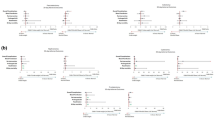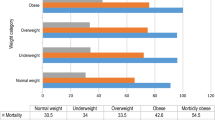Abstract
Purpose
To investigate the possible impact of obesity, as assessed by body mass index (BMI), on outcome in surgical intensive care unit (ICU) patients.
Methods
Prospectively collected data from all consecutive adult patients admitted to our ICU between January 2004 and January 2009 were analysed retrospectively. BMI was calculated using the formula: BMI = body weight/height2 (kg/m2), and patients were grouped as underweight (<18.5 kg/m2), normal weight (18.5–24.9 kg/m2), overweight (25–29.9 kg/m2), obese (30–39.9 kg/m2) and very obese (≥40 kg/m2).
Results
Among the 12,938 patients who were admitted to our ICU during the study period, 9,935 (76.8%) had complete height and weight data and constituted the study group. The mean BMI was 27.1 ± 5.0 kg/m2. Overall, 34.4% of the study population had normal BMI, 1.8% were underweight, 41.2% were overweight, 20.8% were obese and 1.8% were very obese. The ICU mortality rate was similar among BMI subgroups, but hospital mortality was higher in underweight patients than in patients with normal BMI (17.8% versus 11.1%, P = 0.006). On multivariate Cox regression analysis, being overweight [hazard ratio (HR) 0.86, 95% confidence interval (CI) 0.74–0.99, P = 0.047] or obese (HR = 0.83, 95% CI = 0.69–0.99, P = 0.047) was independently associated with lower 60-day in-hospital mortality, with normal BMI as the reference category. Risk of death increased in very obese patients, especially after neurosurgical procedures (HR = 0.3, 95% CI = 1.06–8.48, P = 0.039).
Conclusion
In this cohort of surgical ICU patients, being overweight or obese was associated with decreased risk of 60-day in-hospital mortality.

Similar content being viewed by others
References
Calle EE, Thun MJ, Petrelli JM, Rodriguez C, Heath CW Jr (1999) Body–mass index and mortality in a prospective cohort of US adults. N Engl J Med 341:1097–1105
Haslam DW, James WP (2005) Obesity. Lancet 366:1197–1209
Adams KF, Schatzkin A, Harris TB, Kipnis V, Mouw T, Ballard-Barbash R, Hollenbeck A, Leitzmann MF (2006) Overweight, obesity, and mortality in a large prospective cohort of persons 50–71 years old. N Engl J Med 355:763–778
Bercault N, Boulain T, Kuteifan K, Wolf M, Runge I, Fleury JC (2004) Obesity-related excess mortality rate in an adult intensive care unit: a risk-adjusted matched cohort study. Crit Care Med 32:998–1003
Lee WY, Mokhlesi B (2008) Diagnosis and management of obesity hypoventilation syndrome in the ICU. Crit Care Clin 24:533–549 vii
Joffe A, Wood K (2007) Obesity in critical care. Curr Opin Anaesthesiol 20:113–118
El Solh A, Sikka P, Bozkanat E, Jaafar W, Davies J (2001) Morbid obesity in the medical ICU. Chest 120:1989–1997
Goulenok C, Monchi M, Chiche JD, Mira JP, Dhainaut JF, Cariou A (2004) Influence of overweight on ICU mortality: a prospective study. Chest 125:1441–1445
Brown CV, Neville AL, Rhee P, Salim A, Velmahos GC, Demetriades D (2005) The impact of obesity on the outcomes of 1,153 critically injured blunt trauma patients. J Trauma 59:1048–1051
Bochicchio GV, Joshi M, Bochicchio K, Nehman S, Tracy JK, Scalea TM (2006) Impact of obesity in the critically ill trauma patient: a prospective study. J Am Coll Surg 203:533–538
Nasraway SA Jr, Albert M, Donnelly AM, Ruthazer R, Shikora SA, Saltzman E (2006) Morbid obesity is an independent determinant of death among surgical critically ill patients. Crit Care Med 34:964–970
O’Brien JM Jr, Welsh CH, Fish RH, Ancukiewicz M, Kramer AM (2004) Excess body weight is not independently associated with outcome in mechanically ventilated patients with acute lung injury. Ann Intern Med 140:338–345
Brown CV, Rhee P, Neville AL, Sangthong B, Salim A, Demetriades D (2006) Obesity and traumatic brain injury. J Trauma 61:572–576
Morris AE, Stapleton RD, Rubenfeld GD, Hudson LD, Caldwell E (2007) Steinberg KP (The association between body mass index and clinical outcomes in acute lung injury. Chest 131:342–348
Sakr Y, Madl C, Filipescu D, Moreno R, Groeneveld J, Artigas A, Reinhart K, Vincent JL (2008) Obesity is associated with increased morbidity but not mortality in critically ill patients. Intensive Care Med 34:1999–2009
Hogue CW Jr, Stearns JD, Colantuoni E, Robinson KA, Stierer T, Mitter N, Pronovost PJ, Needham DM (2009) The impact of obesity on outcomes after critical illness: a meta-analysis. Intensive Care Med 35:1152–1170
Oliveros H, Villamor E (2008) Obesity and mortality in critically ill adults: a systematic review and meta-analysis. Obesity (Silver Spring) 16:515–521
Oreopoulos A, Padwal R, Kalantar-Zadeh K, Fonarow GC, Norris CM, McAlister FA (2008) Body mass index and mortality in heart failure: a meta-analysis. Am Heart J 156:13–22
Le Gall JR, Lemeshow S, Saulnier F (1993) A new Simplified Acute Physiology Score (SAPS II) based on a European/North American multicenter study. JAMA 270:2957–2963
Vincent JL, Moreno R, Takala J, Willatts S, de Mendonca A, Bruining H, Reinhart CK, Suter PM, Thijs LG (1996) The SOFA (Sepsis-related Organ Failure Assessment) score to describe organ dysfunction/failure. On behalf of the Working Group on Sepsis-Related Problems of the European Society of Intensive Care Medicine. Intensive Care Med 22:707–710
Vincent JL, de Mendonca A, Cantraine F, Moreno R, Takala J, Suter PM, Sprung CL, Colardyn F, Blecher S (1998) Use of the SOFA score to assess the incidence of organ dysfunction/failure in intensive care units: results of a multicenter, prospective study. Working group on “sepsis-related problems” of the European Society of Intensive Care Medicine. Crit Care Med 26:1793–1800
Miranda DR, de Rijk A, Schaufeli W (1996) Simplified Therapeutic Intervention Scoring System: the TISS-28 items–results from a multicenter study. Crit Care Med 24:64–73
Finkielman JD, Gajic O, Afessa B (2004) Underweight is independently associated with mortality in post-operative and non-operative patients admitted to the intensive care unit: a retrospective study. BMC Emerg Med 4:3
Garrouste-Orgeas M, Troché G, Azoulay E, Caubel A, de Lassence A, Cheval C, Montesino L, Thuong M, Vincent F, Cohen Y, Timsit J (2004) Body mass index. An additional prognostic factor in ICU patients. Intensive Care Med 30:437–443
O’Brien JM Jr, Phillips GS, Ali NA, Lucarelli M, Marsh CB, Lemeshow S (2006) Body mass index is independently associated with hospital mortality in mechanically ventilated adults with acute lung injury. Crit Care Med 34:738–744
Romero-Corral A, Montori VM, Somers VK, Korinek J, Thomas RJ, Allison TG, Mookadam F, Lopez-Jimenez F (2006) Association of bodyweight with total mortality and with cardiovascular events in coronary artery disease: a systematic review of cohort studies. Lancet 368:666–678
Salahudeen AK (2006) The obesity paradox as it relates to survival and hypertension in dialysis patients. Nephrol Dial Transplant 21:1729
Wurzinger B, Dunser MW, Wohlmuth C, Deutinger MC, Ulmer H, Torgersen C, Schmittinger CA, Grander W, Hasibeder WR (2010) The association between body–mass index and patient outcome in septic shock: a retrospective cohort study. Wien Klin Wochenschr 122:31–36
Druml W, Metnitz B, Schaden E, Bauer P, Metnitz PG (2010) Impact of body mass on incidence and prognosis of acute kidney injury requiring renal replacement therapy. Intensive Care Med 36:1221–1228
Tremblay A, Bandi V (2003) Impact of body mass index on outcomes following critical care. Chest 123:1202–1207
Rose DK, Cohen MM, Wigglesworth DF, DeBoer DP (1994) Critical respiratory events in the postanesthesia care unit. Patient, surgical, and anesthetic factors. Anesthesiology 81:410–418
Acknowledgments
Supported by an unrestricted grant of the Ministry of Culture Thuringia (Landesprogramm ProExzellenz; PE 108-2), the Foundation of Technology, Innovation and Research Thuringia (STIFT) and the German Sepsis Society (GSS).
Author information
Authors and Affiliations
Corresponding author
Electronic supplementary material
Below is the link to the electronic supplementary material.
Rights and permissions
About this article
Cite this article
Hutagalung, R., Marques, J., Kobylka, K. et al. The obesity paradox in surgical intensive care unit patients. Intensive Care Med 37, 1793–1799 (2011). https://doi.org/10.1007/s00134-011-2321-2
Received:
Accepted:
Published:
Issue Date:
DOI: https://doi.org/10.1007/s00134-011-2321-2




